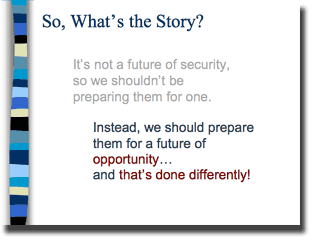Yesterday morning, I wrote (It’s not Just Technology) about how tech conference sessions that focused on the what and how of technology drew far more participants than those that explored the why. Well, my last session yesterday was an exception.
The morning began at 8:30 with a presentation about podcasting. I gave a half-full auditorium of educators a general overview of podcasting and then we produced a program together. It should appear on Connect Learning in the next few days. That was followed by a presentation about blogging — another overview. But I emphasized that, as a technology, blogging is entirely unimpressive — that it is the people network that has caused the emerging impact of the blogosphere.
I had delivered my Telling the New Story address the day before to an audience of about 20, but yesterday morning, when I repeated the presentation, it was to a nearly full auditorium. I’m not sure why, but I was very happy about that.
 This was the 4th or 5th time I had delivered that address, and it has undergone extensive revisions each time. I think now, that it is ready for prime time. And I think what did it for me was when I capped the presentation off with a final slide (to the right), just before leaving my hotel room.
This was the 4th or 5th time I had delivered that address, and it has undergone extensive revisions each time. I think now, that it is ready for prime time. And I think what did it for me was when I capped the presentation off with a final slide (to the right), just before leaving my hotel room.
Now I’ll probably tweak the syntax a bit, but I feel that this is the head of the nail. Our curriculum is based on a future that can be clearly described and depended on. It’s one where people graduate from their schooling with the skills they need to get and hold a job for 30 to 35 years. If you advance in your job, it is because of personal skills or talents that you have. It’s a future of security — and I speak here from a U.S./Western/industrial perspective.
But largely because of advances in technology, the tools that we use to accomplish our goals change, and as a result, so do the skills that are required. The new tools, and the socio-environmental challenges that result present new questions and new problems. Security is gone.
However, these new tools, new skills, and new capabilities to harness our resources in far more efficient ways open previously unimagined opportunities for dramatically improving the human condition and the condition of our planet.
What is the difference between preparing children for a future of security, and preparing children for a future of opportunity?
What do you?

I believe your question is similar to the “process or product” debate. It seems that we once judged growth primarily on products (exams, scores, papers, fact recall). Today, we focus more on the process of learning, and the relationship a student builds with his or her own abilities and motivation. This can be taken too far– as in cases where students are protected from all possible negative judgements. Also, simply moving assessment to portfolios isn’t the total answer.
What may be most important is enabling students to be more independent in their use of tools and information, facilitating their progress, but being honest and clear when either process or products are below standard. Students need ownership in their growth beyond A grades. These higher stakes may sometimes consume more time, and occassionally create more stress, but even that underlies the message that “the future is not secure.” Flexibility, work ethic and humility in appraising one’s acheievements and stengths may lead to the best access to future opportunities.
David, as I teach my third graders, I think about this a lot – what will their future be? I use a lot of tech stuff in instruction, so one of the big questions for me is that when they get out of high school 9 years from now, how will what they have learned be of any use to them? – especially in technology.
The answer for me, for now, is that what they learn right now, in my class, in third grade, will prepare them to be fearless and eager learners down the road. Not to mention competent ones. Simply, they are learning how to learn – new systems, new ways of looking at things. Their confidence grows enormously as a result.
And sometimes, the technology doesn’t change as fast as we might think. I have middle school kids coming back to thank me for teaching them how to use PowerPoint – because they are the only kids in their classes who know how to use it, and now they are teaching their peers. yikes. – Mark
Well, for one thing, you have to look at the idea of “standards” differently. In a worst-case scenario, we develop standards that are a snapshot of today’s (or yesterday’s) critical skills, which may have no connection at all to what our kids will need to know in the future.
The other issue I’m really concerned about is innovation. If kids are going to be able to create new opportunities, they need to be innovative. How do you resolve the inherent conflict between standards and innovation? Can we develop a system where the standards are the foundation upon which innovative skills are built?
I spent some time yesterday talking to some teachers from a district where the technology is so centrally controlled that classroom teachers can’t try anything new. If teahcers can’t be innovative, I can’t see how they can teach their students to be innovative.
I think standards support security (“I know what my kids will need to learn and be able to do 12 years ahead of time”), but innovation is necessary for opportunity (which requires new ideas in response to unexpected situations).